2017_2018学年八年级英语上册Unit3Adayout(第4课时)Grammar教案(新版)牛津版
- 格式:doc
- 大小:37.00 KB
- 文档页数:3
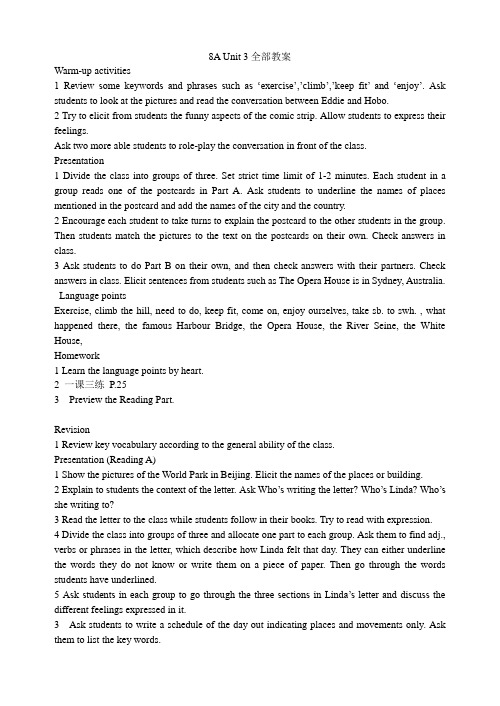
8A Unit 3全部教案Warm-up activities1 Review some keywords and phrases such as ‘exercise’,’climb’,’keep fit’ and ‘enjoy’. Ask students to look at the pictures and read the conversation between Eddie and Hobo.2 Try to elicit from students the funny aspects of the comic strip. Allow students to express their feelings.Ask two more able students to role-play the conversation in front of the class.Presentation1 Divide the class into groups of three. Set strict time limit of 1-2 minutes. Each student in a group reads one of the postcards in Part A. Ask students to underline the names of places mentioned in the postcard and add the names of the city and the country.2 Encourage each student to take turns to explain the postcard to the other students in the group. Then students match the pictures to the text on the postcards on their own. Check answers in class.3 Ask students to do Part B on their own, and then check answers with their partners. Check answers in class. Elicit sentences from students such as The Opera House is in Sydney, Australia. Language pointsExercise, climb the hill, need to do, keep fit, come on, enjoy ourselves, take sb. to swh. , what happened there, the famous Harbour Bridge, the Opera House, the River Seine, the White House,Homework1 Learn the language points by heart.2 一课三练P.253 Preview the Reading Part.Revision1 Review key vocabulary according to the general ability of the class.Presentation (Reading A)1 Show the pictures of the World Park in Beijing. Elicit the names of the places or building.2 Explain to students the context of the letter. Ask Who’s writing the letter? Who’s Linda? Who’s she writing to?3 Read the letter to the class while students follow in their books. Try to read with expression.4 Divide the class into groups of three and allocate one part to each group. Ask them to find adj., verbs or phrases in the letter, which describe how Linda felt that day. They can either underline the words they do not know or write them on a piece of paper. Then go through the words students have underlined.5 Ask students in each group to go through the three sections in Linda’s letter and discuss the different feelings expressed in it.3 Ask students to write a schedule of the day out indicating places and movements only. Ask them to list the key words.6 Check students’ understanding. Ask comprehension questions.Presentation (Reading B)1 Ask students to read the conversation on their own.2 Ask students to replace the underlined phrase with the correct words. Encourage less able students to find the words in the letter on page 36&37.3 Ask students to compare answers in pairs. Then ask two students to read out the conversation in class to check the correct answers.4 Ask students to write the list of new words and definitions in their vocabulary record books.5 Divide the class into pairs and ask them to read the conversation.Presentation (Reading C)1 Do Part C as a class competition.2 Ask students to close their books . Then read the sentences at random one at a time. Write them on the Bb only one at a time. Make it clear that students raise their hands when they are ready to answer.3 Ask students to correct the false sentences. Allow less able students to open their books and find the correct information.4 Talk to students about a home page to focus their attention on Part C2. Then ask them to sequence the pictures on Daniel’s home page on their own.5 Check answers as a whole class activity.6 Ask students if there are any disagreements. Encourage them to explain why they have selecteda certain sequence in order to identify reasons for mistakes.Language points (Part A)Invite sb. to do, at the beginning, get on a coach, be boring, on the highway, feel sick, most of the trip, arrive at, be made of metal, in front of, places of interest, from all over the world, the real ones in Egypt, an amazing day, join in, teach himself, a home page, for everyone to look at Language points (Part B)Travel from one place to another, movement of cars, the main road, come up from your stomach, the tall metal building, the old stone buildingLanguage points (Part C)It takes sb. time to doHomework1 Learn the language points by heart.2 一课三练P.26-273 Preview the V ocabulary Part.Presentation (Vocabulary)1 Part A is a recognition task asking students to identify the English names of popular places of interest in Beijing. Bring in photos of these places.2 Explain the context of the tasks. Ask students to study the pictures and words.2 Ask students to check answers with a partner. Then check the correct answers with the whole class by asking individual students to read out the sentences.3 Part B is a problem-solving task and students need to use their existing knowledge of Beijing to do it. Bring in a map of Beijing.4 Revise means of transport by asking students how they go to school or work.5 Ask students to do the task in pairs. Then ask students in a pair to compare their answers with another pair. Then ask students to take turns to read the sentences aloud to check the correct answers.Language pointsThe Monument to the People’s heroes, the red maple leaves, walk slowly around the big lake, feel the beauty of…, the names of the transport, more than an hour.Homework1 Learn the language points by heart.2 一课三练P.283 Preview the Grammar Part.Presentation (Grammar Part A)1 Elicit from students the context illustrated in the picture.Focus students’ attention on the trip and how the Class 1, Grade 8 students felt at the time. E.g., How was the trip? (boring, too long) Then ask them to form sentences with the keywords and write them on the Bb. E.g., The trip was boring. It was too long. Ask them to join the two ideas in one sentence.2 Ask students to list other similar ideas about the journey using ‘and’.3 Ask students to combine the two contrasting ideas--- of a boring trip on the coach and a wonderful day. Ask them when we use ‘and’ and ‘but’ to elicit the rulers.4 Ask students to combine the two options.5 Elicit a few sentences from students’ own experienc es, focus on the sentences with the same subjects and verbs.6 This is a deductive learning activity. Encourage students to work it out as a problem-solving task following a set sequence of deduction. Students should be able to work out the correct joining word and also which words to delete by applying rules on Page 41.7 Elicit feedback from the class. Ask students to read out their new sentences. The others listen carefully and express agreement or disagreement. If there’s any disagreement, encourage students to explain their reasons to help them focus on the different details of the rule. Presentation (Grammar Part B)1 Read the sample sentences. Ask students to identify the verb and the ‘to’-infinitive in each sentences.2 Elicit other verbs that are us ually used with ‘to’-infinitive. Give them the extra examples listed on page 43.3 Ask students to complete ‘Work out the rule!’ at the bottom of the page. For less able students, tell them to go through the example sentences and the explanations again.4 Ask students to complete the conversation in pairs. They should make sense of the sentences before they select a verb. Remind less able students that they need to use ‘to’-infinitives in the conversation.6 Ask students to read the conversation in pairs. Ask a pair of more able students to read out the conversation to the class.Presentation (Grammar Part C)1 Write down some sentences containing reflexive pronouns. You can use the following examples:* I fell over and hurt myself.* My baby sister can feed herself.* My cat cleans itself every day.* We found ourselves in the centre of the city.2 Underline the reflexive pronouns in the sentences. Explain the use of reflexive pronouns. Tell them we use them when the subject and the object are the same person or thing.3 Explain the difference between reflexive and personal pronouns by giving some examples.4 Go through the table. Make sure students are able to distinguish between the singular and plural forms.5 Write some more verbs, e.g., ‘teach’, ‘give’, ‘buy…for’,’ look after’,etc.6 Ask students to complete ‘Work out the rule!’ at the bottom of the page.7 Explain the context and tell students that they need to find out Linda and Simon’s secret. Ask students to read the cartoon story first without working out the correct reflexive pronouns. Check the understanding of the vocabulary.8 Then ask students to go through the story again and work out the correct reflexive pronoun for each blank.9 Ask more able students to read out the speech bubbles in sequence. The rest of the class should listen carefully and check their answers.Language pointsDecide to do, prepare to do, see the sunset, take some photos of it,climb the rocks, hide-and-seek, pull himself up, luckily, do not tell anybody about this, keep their secret to themselves Homework1 Learn the language points by heart.2 一课三练P.29-303 Preview the Integrated skills Part.Presentation (Integrated skills A)1 Talk to students about different school events. Elicit from students names of such events, e.g.,a sports day, a funny day, a school fair, etc.2 Set the context of organizing sports, music, drama or any other events involving competition.3 Briefly review language required for a schedule using your students’ own experience. Useinformation based on the school. Write some details on the Bb.4 Read the poster in pairs. Ask some questions to find out the main points, e.g. , What’s it about? Who is it about? What will happen? Where will it happen? When?4 Ask students to look at Kitty’s notes and complete as much of the schedule as possible on their own. Encourage them to find the answers in the poster and underline them.5 Play the recording for Part A2 and ask students to complete the rest of the notes on their own.Play the recording again so that Ss are able to check, confirm or change their initial responses.6 Ask more able student to read the completed notes to the whole class to check answers .7 Present Part 3 as a quiz reading the sentences one by one. Ask more able student to rewrite the false statements with the correct details.Presentation (Integrated skills B)1 Ask students to practice the conversation in pairs and then change roles.2 Close the books and listen to me while I read the conversation. Ask students to repeat the sentences as they hear them.3 Encourage Ss to memorize the sentences. Ask them to pretend they are talking on the phone.4 Ask Ss to work in pairs and use the conversation as a model to make suggestions about visitinga place, express their opinions and make arrangements.Language pointsThe final of…, take place, cheer for our team, with your support, we will win, half-time, presentation of cup and medals, per person, cost of the trip, over an hour, Shall we go to the Great Wall?, I’m afraid…, Why don’t we…?, play hide-and-seekHomework1 Learn the language points by heart.2 一课三练P.313 Preview the Study skills, Main task & Checkout Part.Presentation (Study skills)1 Make Ss aware of the difference between facts and opinions. Ask more able students what is a fact and what is opinion.2 Ask students to read the leaflet about the World Park.3 When they are comparing their answers, ask them to underline the words which express opinions and personal feelings.Language points (Study skills)467,000 square metres in areaPresentation (Main task)1 Introduce the topic of planning a day out. Ask Ss to bring in brochures of local places which they would like to visit.2 Elicit from Ss the need for accuracy in terms of times, dates, transport, places and types of activities.3 Remind students the context of this section. Go through the plan in Part A and point out the information which Kitty and Daniel want to include in the invitation letter.4 Tell Ss that the model plan prepares them for writing an invitation letter with their own information and details.5 Ask students to go through kitty and Daniel’s letter quickly and complete it on their own.6 Direct Ss’ attention to the different parts of the letter. Ask students to cover the promp ts on the left. Ask them to match them with the corresponding parts in kitty and Daniel’s letter.7 Ask students to write a rough draft using the plans they have prepared in Part B.Language points (Main task)Is coming to visit you, all the way to…,Presentation (Checkout)1 Revise the use of joining words, reflexive pronouns and verbs +to infinitives.2 Ask students to read through the conversation and complete the sentences.3 Check the correct answers with the whole class and tell them to write their scores in the paw.4 Ask Ss to look at the pictures in Part B and explain the context. Ss then write the names of the places on their own.Language points (Checkout)Planned to go, pack my bag instead, play badly, shuttle bus, go climbing on rocksHomework1 Learn the language points by heart.2 一课三练P.32-343 Preview the Unit 4.。
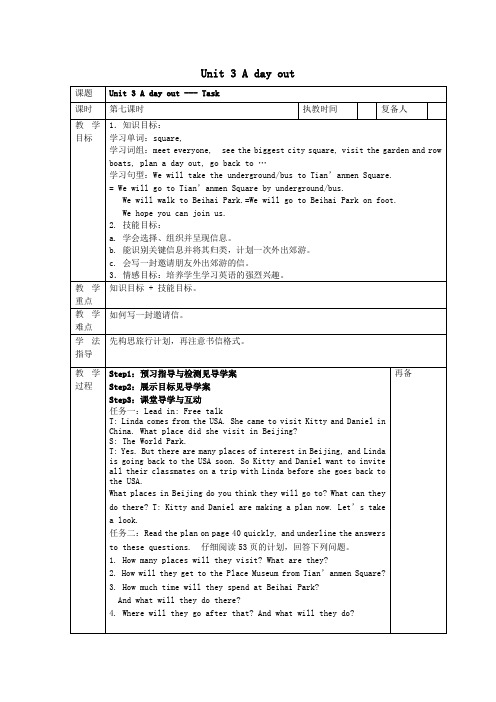
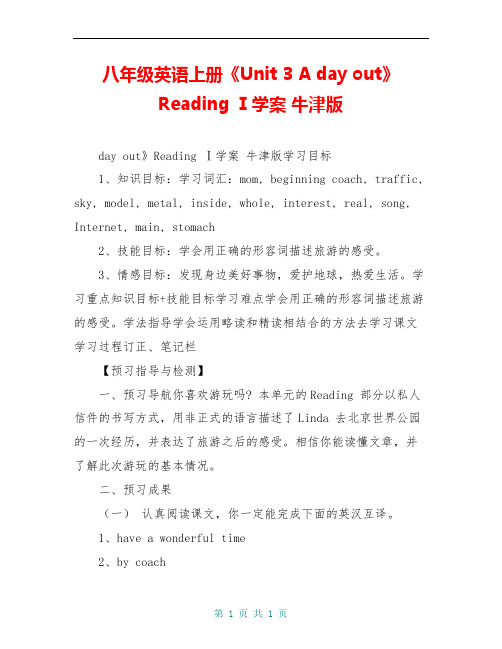
八年级英语上册《Unit 3 A day out》Reading Ⅰ学案牛津版day out》Reading Ⅰ学案牛津版学习目标1、知识目标:学习词汇:mom, beginning coach, traffic, sky, model, metal, inside, whole, interest, real, song, Internet, main, stomach2、技能目标:学会用正确的形容词描述旅游的感受。
3、情感目标:发现身边美好事物,爱护地球,热爱生活。
学习重点知识目标+技能目标学习难点学会用正确的形容词描述旅游的感受。
学法指导学会运用略读和精读相结合的方法去学习课文学习过程订正、笔记栏【预习指导与检测】一、预习导航你喜欢游玩吗? 本单元的Reading 部分以私人信件的书写方式,用非正式的语言描述了Linda 去北京世界公园的一次经历,并表达了旅游之后的感受。
相信你能读懂文章,并了解此次游玩的基本情况。
二、预习成果(一)认真阅读课文,你一定能完成下面的英汉互译。
1、have a wonderful time2、by coach3、be on the highway4、get off quickly5、an amazing day6、the real ones7、一开始8、觉得恶心9、模型金字塔10、亲自11、歌舞游行12、自学如何制作网页(二)你能根据句意及所给的提示完成单词吗?1、The two cities are linked by a h 、2、 There are lots of places of i in China、3、This isn’t a real plane、 It is just a m 、4、There is heavy t during the rush hour、5、 I am very hungry、 I can even hear my s singing、6、 We can go to Beijing on a c 、It is comfortable to travel by it、7、Daniel (教)Kitty how to make a kite yesterday、8、 The Eiffel Tower is made of m 、9、 Ann would like to i her friends to her birthday party、10、At the (开始), I didn’t like this subject、(三)同学们,在完成上面练习以后,请你思考下列问题。
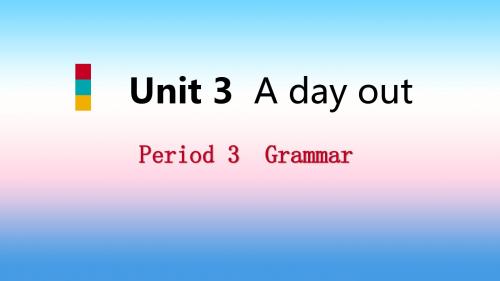
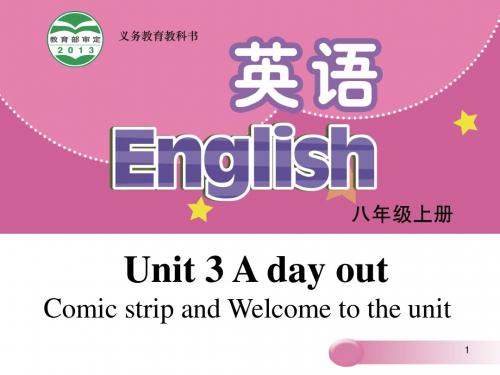
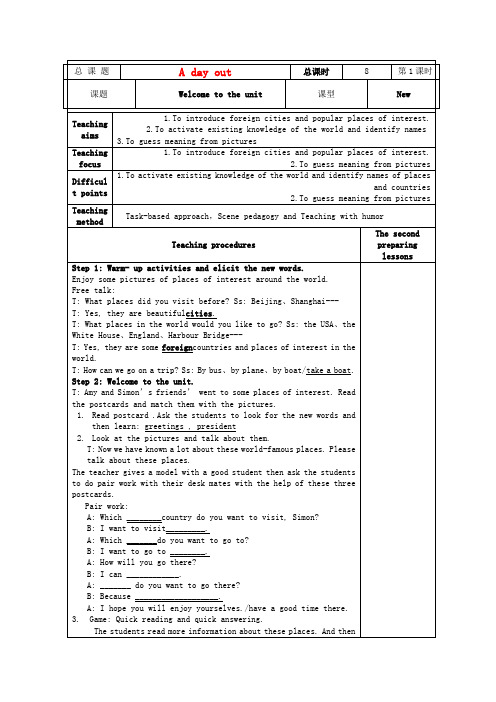
A day out课题:Main task (第八课时)教学目标1.选择、组织并呈现信息。
2.识别关键信息并将其归类,计划一次外出旅游。
3.写信邀请朋友外出旅游。
课堂学习阅读第53页计划,填表:A trip planWho (participants)When (date)How (transportation)How longWhere to meetWhat to visit课堂检测一、翻译下列句子:1、我想要邀请你去茶社喝茶。
I want ______________________________________.2、如果你想去天安门广场,请尽早让我知道。
If you want _______________, please ________________.3、我们将为她计划一天的出游。
We are _____________________________________________.4、我们将上午7:30在校门口见面,下午4:30乘地铁返校。
We will _____________________and ____________________.5、我希望你能加入我们。
I hope _____________________________________________.6、我们将使它成为每个人都真正快乐的一天。
We will ___________________________________________ for everyone.二、根据汉语意思完成下列句子,并在括号内写上“F”(事实)或“O”(观点):1.Beijing is _________(世界上最好的城市之一). ( )2.The Great Wall is ____________(最棒的地方) to visit. ( )3.There are over a hundred _______________(旅游胜地) from all over t he world in the World Park. ( )4.There is a song and ___________(跳舞游行). ( )5.The Gol den Gate Bridge here looks better than_____________(真的那座). ( )6.Linda will ______________(回到) the USA soon. ( )三.课后反思:选择、组织并呈现信息。
2019-2020学年八年级英语上册 Unit 3 A day out Grammar教案牛津版I. Teaching aims and learning objectivesBy the end of the lesson, students should be able to:1. use “as … as” and “not as/so … as” properly;2. use reflexive pronouns correctly;3. know how to use some new words and expressions.II. Teaching contents1. New words and phrases: itself, pull, rock, luckily, climber, keep the secret tooneself, look at each other, hurt yourself, enjoyedourselves, pull himself up the rocks2. New structures: The bus is as comfortable as those in the USA.The Eiffel Tower is not as tall as the real one in France.The model Sydney Opera House looks as wonderful as that in Australia.Linda enjoyed herself in the park.Linda’s parents will go and see the photos for themselves.III. Focus of the lesson and predicted area of difficultyHow to use “(not) as/so … as”.How to use reflexive pronouns correctly.IV. Teaching proceduresA Using as … asStep 1 Lead-inShow the picture of West Lake and Slender West Lake.T: I know you all love travelling. Now I’ll show you two beautiful lakes. Do you know them? And where are they? (The West Lake of Hangzhou and the Slender West Lake of Yangzhou.) Do you think the Slender West Lake is as beautiful as the West Lake? (Yes.) Why is this lake called the Slender West Lake? Is the Slender West Lake as big as the West Lake? (Because the Slender West Lake is smaller and slimmer than the West Lake.) It is as beautiful as the West Lake, though it’s not as big as the West Lake, right?【设计意图】通过本单元旅游话题呈现两张景点的图片,在讨论过程中导入本课学习目标。
1
Unit 3 A day out
课题及内容 Unit 3 A day out 第四课时Grammar 总课时数 7
教学 目标 1.掌握as...as的用法。
2.掌握反身代词的用法。
教 学
重、难
点
1.掌握as...as的用法。
2.掌握反身代词的用法。
教 学 设 计
Step 1:Daily greetings:
T:Good morning,everyone.
S:Good morning.
T:How are you?
S:I'm fine,thank you.And you?
T:I'm OK.Thank you.Sit down,please.
Step 2:Show" Learning aims"
T:Today we will learn Unit 3 Grammar.Please
look at our " Learning aims"(Then I read it slowly.)
T:Are you clear?
S:Yes.
T:Let's go on.
Step3:Show" Guide One"to the students.
Guide One
1.Read the sentences in Part A ,then work out the rules.
2.Complete the sentence under each picture with as...as or notas...as.
Let's have a match and see who can do it best.
T:We use as...as to say that people or things are the same in some ways.
2
·We use not as...as to say that people or things are not the same in some ways.
Step4:Show" Guide Two"to the students.
Guide Two
1.Read the sentences in Part A ,then work out the rules.
2.Complete the sentences with the correct reflexive pronouns.
Let's have a match and see who can do it best.
Step5:Class Exercise (一)
一.连词成句,注意“as...as/not as...as”的位置。
1,is/Simon/happy/the/three/as/girls/as.
______________________________________________
2.mine/expensive/pen//your/not/is/as/as
______________________________________________
二.根据句意,用正确的反身代词填空。
1.At the party,we enjoyed_________and they enjoyed________.
2.I can take care of________,but my sister can’t take care of ______.
3.My pet dog can find some food for__________.
Class Exercise (二)
3
板书设计 Unit 3 A day out
课后反思